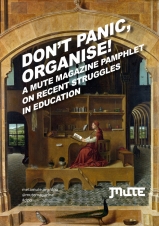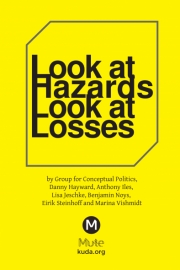Capitalism, Biotechnology, Securitisation and Other Scary Words!
Speculation and risk management, once the preserve of finance, have become defining traits of all facets of contemporary capitalism – from military planning to stem cell research. The Melancholic Troglodytes review two recent books exploring the expansion of this speculative logic
There are distinct ideological ties of continuity between these two contributions. Influenced as they are by post-structuralist and autonomist currents, they attempt to project certain characteristics within contemporary capitalism into the near future in order to theorise emergent trends. Both texts link these trends to novel forms of warfare and security. Moreover, without stating it explicitly, they both employ discourse and rhetorical analysis as methodology. Thematically, however, they focus on different areas of capitalist development. Cooper's book looks at the rise of biotechnology within neoliberalism whilst Martin identifies risk management and the derivatives market as the driving force of a new form of American imperialism. Below we will review these two texts separately although significant overlaps will be pointed out as and when applicable.
Life as Surplus
We were impressed by Cooper's book on a number of fronts. First, it fills a knowledge gap in fields too many radicals usually ignore: biotechnology, tissue-engineering, stem cell research and AIDS. Second, following on from Foucault, there is a concerted effort to demonstrate how the realms of biological (re)production and capital accumulation have been moving closer since the 1970s. Third, she locates ‘the rhetorical form of neoliberal violence in contemporary discourses of biological security [and humanitarianism]’ (p. 12). Fourth, she underscores that the IMF/World Bank project is an assault directed simultaneously against the US proletariat and those of the ‘developing’ world (she uses the unfortunate sociological term underclass rather than proletariat, but this should not detract from the force of her argument). Finally, she links the evangelical right-to-life movement with ‘American indebtedness and its role in the world economy today’ (p. 14).

Image: Book cover
In chapter one, Cooper describes how the Club of Rome documented the crisis of Fordism in the early 1970s and how a group of right-wing ‘post-industrial’ economists took up the challenge and offered solutions for the restructuring of capitalism based on post-Fordist imperatives that would later be called ‘bioeconomy’ - a kind of libertarian, free market vitalism. In the 1980s this trend led to a self-imposed reinvention of the petrochemical and pharmaceutical industries ‘as purveyors of the new, clean life science technologies’ (p. 22). Mass production has not been made obsolete, rather ‘it has been demoted as the principle source of surplus value within a higher-order mode of production’ (p. 24). The federal government aggressively encouraged high-risk research and development in the life sciences using a highly liquid stock market which included pension funds and (indefinite) loans from foreign nations which culminated in ‘an effective debt imperialism’ (p. 30).
The research fund thus generated from internal and external proletarian surplus wealth began to pay dividends around 1973 with the advent of recombinant DNA production or genetic engineering - a post-Fordist production technique which allegedly did away with ecological limits to growth. Now pollution and environmental crises were viewed not so much as wastage but as prerequisites for innovation and regeneration. In parallel to this move, the boundaries of what was considered ‘life’ were pushed further with the discovery of ‘extremophile microbes’ by bioscientists. These are microbes that flourish under extreme geochemical and physical conditions (p. 34). Post-Fordist life production, unlike Fordist industrial growth, is not subject to depletion or diminished returns. As Cooper puts it, ‘Life creates its own limits to growth only to expand them’ (p. 36). This new expanded life continuously reanimates itself in ever more complex combinations (p. 38). Research in life biology was cemented with exobiological investigations led by NASA into survival in extreme environments. Cooper shows how all this vitalism in the life sciences is being taken up by neoliberal economists who are going beyond Adam Smith's principle of equilibrium and using crisis as a productive self-organising tool. In Cooper's own words:
The new liberal economists ... remain true liberals, in the sense that they believe in the essential autonomy of the market ... yet in place of Adam Smith's principle of equilibrium ... they argue that economics evolve most productively in far-from-equilibrium conditions (p. 43).
In other words what is neo about neoliberalism is the coupling of the principle of self-organisation with the necessity of continual crisis.
Chapter two is a rich analysis of the pharmaceutical industry emphasising how AIDS was confronted as a military emergency and how international legal frameworks were galvanised (primarily by the USA) to prevent countries like India, China and South Africa from manufacturing cheap generic drugs (p. 53). Readers will find Cooper's analysis of ex-president Mbeki rewarding especially in the context of Mbeki's recent forced resignation (p. 68). The discussion on AIDS moves swiftly onto a reformulation of imperialism and the intensification of sex work. Basing her analysis on vol. 3 of Capital, Cooper argues there is a ‘structural relationship between capital's moment of crisis, debt creation, and the periodic devaluation of human life’ (p. 60).
In chapter three, Cooper discusses the biological turn in the ‘War on Terror’. This chapter should be read in conjunction with Martin's chapter two on ‘Derivative Wars’. Both authors attempt to chart the changes in warfare from a modernist (Cold War) approach to newer forms of waging war - variously referred to as ‘postmodern’, ‘permanent’ or ‘distributive’ warfare. In this new phase, pre-emption and full-spectrum dominance replace the doctrine of mutual deterrence and the frontier between warfare and public health (as well as the distinction between real and imaginary risks) disappears. New pathogens cross supposedly impenetrable borders. This invisible, incubating, apocalyptic threat has helped to bring biowarfare back from the margins to the centre of US foreign policy (p. 86). Cooper then launches into a discursive analysis of the militarisation of humanitarian aid, applied both in foreign lands as well as internally. Her analysis of disaster response (p. 93) has parallels with Caffentzis' account of FEMA's handling of Hurricane Katrina,i although she also links the aftermath of Katrina to survivalist, neo-fundamentalist interpretations of disaster: ‘It is quite striking that both evangelicals and Salafist Islamists responded to Hurricane Katrina by interpreting it as an act of divine revenge, occasioned not so much by American foreign policy as by sexual decadence’ (Cooper, p. 100).

All images: Illustrations by Melancholic Troglodytes
In the second half of the book (chapters 4-6), Cooper turns her gaze to the emerging sciences of regenerative medicine which combines stem cell research and tissue engineering. She places this paradigm within post-Fordist productive techniques. The mechanics and philosophy of (Fordist) organ technologies are surveyed through the work of the French physiologists Étienne-Jules Mary (1830-1904) who is credited with the advent of prosthetics and organ transplantation (p. 107). Post-Fordist techniques of regeneration, Cooper argues, have added the new element of the bioreactor whose purpose is ‘to provide the conditions under which a tissue can be modulated, deformed, continuously remolded’ (p. 123).
One of the most original ideas is posited in relation to stem cell research. Cooper suggests this technique is being integrated into an entirely new mode of accumulation, ‘one that is irreducible to either (organic, human) production or reproduction in the Marxian sense’ (p. 131). She believes what is being constituted here ‘is something like a market in embryonic futures ... exchanges [begin] to resemble high-stake casinos more than agricultural markets ... gambling turns back on itself and investing becomes the postmodern game of betting on bets’ (p. 141). So (and this is key to her argument) biological life is not just becoming more commodified, rather it is transmuting into speculative surplus value (p. 148). As she puts it,
When patent law apprehends the value of the stem cell line, it is not in the first instance as an exchangeable equivalent (Marx's definition of a commodity) but as a self-regenerative surplus value, a biological promise whose future self-valorisation cannot be predetermined or calculated in advance (ibid.).

The final chapter is not merely a summing up; it also expands on the relationship between neo-imperialism and the Evangelical Right. The pro-life rhetoric of priests and presidents is examined. Cooper shows how neoconservatives, neoliberals and pro-life advocates have been coming closer since the mid 1970s. She also makes a distinction between early and late Protestantism which we find extremely useful (p. 156). Early Protestantism was about work discipline and hard work. Later manifestations are more attuned to investment, usury, risk taking and supply-side economics. Both neo-imperialism and evangelicalism are ‘founded on the precarious basis of a perpetually renewed debt’ (p. 161). It is this characteristic and a quasi-religious faith in perpetual growth which explains US capitalism's anti-environmentalism.
Constructive Criticisms of Life as Surplus
The following criticisms of Cooper's text are offered in a spirit of cooperation:
Cooper's description of capitalism as being in a state of ‘delirium’ bases itself on Freud's distinction between psychotic delirium and neurotic fantasy (p. 20). These are categories Melancholic Troglodytes dismiss as belonging to a bygone age of ‘scientific’ psychology. The temptation to prettify our analysis by throwing in Freudo-babble into the works should be avoided at all costs.
The book's cursory analysis of the 1970s oil shock (p. 21) would have greatly benefited from the contribution of groups like Midnight Notes Collective.ii The discussion of AIDS, metaphors and witchcraft (p. 71) should have taken on board the writings of Michael T. Taussig on the linkage between commodification and witchcraft as well as the critical input of Susan Sontag who is curiously reduced to a mere footnote (p. 183).iii If Cooper chooses to use the notion of ‘risk’ as a seminal tool of analysis she has to come to terms with Ulrich Beck's work on the subject. Of course she can be as acerbic about Beck's moments of sociological insight as we are, but to ignore Beck is to conceal the genealogy of the concept of risk. In a similar vein we are unaware of Cooper's position regarding the biologist Steve Rose and the geneticist Richard Lewontin but to us discussing embryo research and agricultural reproductive sciences (p. 131) without reference to their outstanding contribution seems a bit blasé. Likewise her analysis of feminist bioethics (p. 136) ought to have taken seriously Fortunati's reworking of Marx on housework and reproductive labour power.iv And the passages on abortion, eugenics and pharmacology would have been strengthened through fusion with ideas from Critical Art Ensemble.v The discussion of ‘debt imperialism’ and the demise of the dollar-gold standard would have been so much more nuanced had Cooper integrated the recent insights of Loren Goldner on the subject.vi
In an attempt to justify the title of the book, Cooper proposes that our feelings of disgust are associated with a ‘surplus of life’ and pathological overproduction. Cancer, for instance, kills through distorted growth and overproduction. She mobilises arguments from the phenomenologist Aurel Kolnai to validate her title choice but for us disgust and excess can also be interpreted using Sade, Bataille or Bakhtin. We find this passagevii somewhat reductionist and would suggest the bourgeoisie quite consciously creates different forms of disgust in different segments of the population at different times and cultures as a crude but effective way of dividing the proletariat. Ironically as Sade, Bataille and Bakhtin all demonstrate the surplus of life, overproduction and excess can at times be turned against capitalism.
Finally, throughout this text Cooper is grappling with a new form of capital accumulation based on biotechnology and regenerative medicine. What the book lacks is a single unifying concept which posits the problem from the perspective of the proletariat. We would suggest Shah-Shuja's notion of ‘hyper-material production’ fits the bill perfectly.viii If we understand Shah-Shuja's arguments correctly, she is suggesting that capitalism is entering a new phase of development where material production and the autonomist concept of immaterial production will be combined with hyper-material production – the application of biotechnology and genetic engineering to labour power. Hyper-material production may very well change the very nature of labour power by creating complex, regenerative, indefinite sources of surplus based on entities whose legal status is being reconfigured right under our nose.
Melancholic Troglodytes' golden star rating for Life as Surplus
Despite some political and epistemological reservations, we would recommend this book to all radicals.
Content originality: (groovy)
![]()
![]()
![]()
![]()
![]()
Presentation style: (good)
![]()
![]()
![]()
![]()
![]()
An Empire of Indifference
The second text to be reviewed here has numerous commonalities with Life as Surplus. However, in truth, we feel far less sanguine about Martin's An Empire of Indifference: American War and the Financial Logic of Risk Management. Martin's central thesis is that American domestic and foreign policies have become dominated by a ‘finance-based logic of risk control’. His ‘Marxist’ analysis ditches the antagonism between bourgeois and proletarian in favour of a dualism based on the ability to take risk: ‘investors’ are those able to ‘avail themselves of wealth opportunities through risk taking’ and those who cannot are considered ‘at risk’. When this dualism is exported to foreign lands the US is basically urging risk taking on the occupied. The minority who make the grade become friendly-lackeys and the majority are classified as bad risk and rejected. Imperialism which was presumably once benign or at least concerned with the development of its colonies has become ‘indifferent’ to the plight of its subjects.

Image: Book cover
The book begins by mentioning the arguments of Hilferding, Lenin and Bukharin on imperialism and nationalism (p. 2-3). We say ‘mentioning’ because Martin does not make his position clear vis-à-vis these canonical texts of orthodox leftism. In fact, not clarifying his political position becomes a nifty way of evading crucial issues of tactics and strategy. He does something similar when he bandies about ideologically loaded terms like ‘dependency’ and ‘underdeveloped’, without making the reader aware of their political ramifications. The vague terminology is supplemented by phrases from other areas of the social sciences such as the cunningly abstract ‘unconscious geographies of opportunity’ (p. 6)!
Following Arrighi, Martin observes how ‘finance has gained prominence during periods of general economic turbulence, restructuring of the social contract, and shifts in global powers’ (p. 7). The same arguments could (and should) be put forward regarding how the restructuring of surplus value extraction gains prominence during times of crisis but sadly the class struggle plays no part in Martin's analysis. This rejection of the social struggle is inadvertently confirmed when Martin describes Marx's feat as ‘a kind of self-critical phenomenology of social wealth’ (p. 7) - a very social democratic perspective!
Throughout there is an almost obsessional desire to link the economic and military spheres of activity. We say ‘obsessional’ because the linkage is repeated like a hypnotic mantra in the hope that a lack of evidence and historical counter-examples do not impede a good yarn. The notion of ‘military preemption’ against terrorists is linked with monetarism's need to control inflation through interest rates adjustment (p. 4). The military policy of ‘forward deterrence’ is the flip-side of central banks increasing the prime lending rate to dampen the creation of money (p. 10). There is nothing new or radical in these parallels - Warren Buffett (ranked richest person in the world by Forbes) warned shareholders about derivatives by describing them as ‘financial weapons of mass destruction’.ix And, yes, we admit there is both real and imaginary linkage between these military and financial policies that need to be foregrounded.
However, there are at least four problems with Martin's analysis here: first, this linkage is applied willy-nilly to every phenomenon (everything is reduced to a risk criterion); second, other segments of the capitalist cycle are ignored in the process (it is as if Marx only wrote volume II of Capital! What a scary thought that is!); third, the distinction between financialisation as a historical tendency (i.e., as a paradigm shift) and financialisation as a temporary policy for dealing with a specific crisis is not underscored; and, finally, it does away with the need to explain contradiction within the system - the proletariat as both the source and limit of capitalist accumulation is taken out of the equation and made invisible (some ‘Marxist’ this Professor Martin!).
In chapter one, Martin traces the shift from notions of ‘security’ to ‘securitisation’. According to Martin, securitisation was the revolution in financial services meant to mitigate risk from local or individual debts like mortgages, car loans and credit card debt (p. 19). If the entrepreneur is the archetypal figure of the age of security who still respected ‘the boundary between property and speculation’, the new archetype of the age of securitisation - the arbitrageur - no longer does so (p. 22). Martin believes this shift began under Carter's presidency rather than Reagan (perhaps we could add by analogy that the shift occurred in this country under Callaghan's premiership rather than Thatcher's).
He then turns to the role of derivatives in this process of financialisation. Derivatives he defines as ‘promissory notes issued between firms’ (p. 31). These derivatives allow debt to serve as a productive medium. Derivatives increase speed and volume in circulation and they delocalise debt. In the process the ‘wall of security between consumer and commercial banking and between domestic credit and foreign debt [is] punctured’ (p. 33). All this is good, interesting stuff which clarifies the current credit crunch. The remainder of the chapter discusses the paradigm shift from modernist to postmodernist warfare. The bits on Patriot Act and the privatisation zeal of Donald Rumsfeld go over familiar ground but are worth a read. Chapter two - ‘Derivative Wars’ - continues this story. This part of the book could be read in conjunction with Cooper's similar thesis about the changing nature of warfare.
We feel there are two dimensions to Martin's analysis of warfare. The positive dimension is generated by a useful discourse analysis of the US bourgeoisie's talk about changing strategies. For example, Martin has studied seminal military texts produced by various think-tanks. He has observed a shift from (early) Fordist assembly line techniques of interchangeable troops inaugurated by the Prussian army (more than a century before Ford himself), to (advanced) Fordism of the post-WW2 era (characterised by command, control, and communication known by the acronym C3) and finally the present post-Fordist period (characterised by command, control, communication, computers, intelligence, surveillance, reconnaissance and known as C4ISR). Some of this information is useful and throws light on intra-classist tensions between Rumsfeld, Cheney and their Pentagon detractors. It may even have practical implications for some sections of the world proletariat down the line.
However, this discourse analysis also has a negative counterpoint whenever Martin doubles up as an armchair General issuing philosophical battleground directives using Deleuze, Guattari or Virilio as mouthpiece. What does Martin (or for that matter Deleuze, Guattari, Virilio or Melancholic Troglodytes) truly know about military affairs? He gives no indication of being in possession of first-hand battleground experience. Perhaps this explains why the section on the ‘Buddy Ethos’ (p. 86-93) where Martin is trying to link pre-modern notions of the warrior mentality with post-modern concepts of soldiery does not quite work. In truth, none of us knows what the bourgeoisie is planning militarily. None of us truly comprehends the technological and strategic transformations under way. None of us is privy to secret Pentagon meetings. In relation to the military terrain, we are reminded of the ancient Egyptians' confrontation with inexplicable plagues and disasters. Unable to resist these forces of destruction the Egyptian priests would spend most of their time contemplating the perfect label. It was believed the perfect naming of a disease could neutralise some of its maleficent impact. Waxing lyrical about dispersed warfare and military jargons and acronyms may be covering up a similar impotence in contemporary analysts.
Now, we are not suggesting this is an area of analysis beyond the social movement's (collective) ability. We are merely pointing out that given our lack of access to the highest echelons of military decision-making and the traditional opacity in this field, perhaps a degree of humility is in order. The market has to conduct its business with a modicum of transparency if it wants the population to buy shares and invest in risky enterprise. The military has no such qualms. Newspapers like the Financial Times and the Economist shed considerably more light on market mechanisms than Jane's Defence Weekly on military planning. Moreover, we are intimately involved in the economy on a daily basis. Every transaction, from mortgage payment to shopping at a supermarket, compels us to think about the implications of monetary policies. But with the exception of those proletarians dodging bombs and bullets in some parts of the globe, most of us do not have military affairs constantly on our brain. All the more reason to avoid arrogant and dogmatic assertions on subjects we are not intimately familiar with. Humility, Professor Martin, humility!
Pages 102-110 contain some old and a few novel observations about the war in Afghanistan. The early Al-Qaeda are compared to a ‘venture capitalist firm ... sponsoring projects submitted by a variety of groups or individuals in the hopes they will be profitable’ (p. 103, Jason Burke quoted by Martin). In one key passage Martin explains that the key strategy of the World Bank in Afghanistan is to move the labouring masses from ‘food-for-work to cash-for-work’ (p. 108). In parallel to creating wage slaves, the World Bank is also attempting to reconstruct a native bourgeoisie. This is one of a handful of references to class in the entire book. We recommend reading this section in conjunction with our brief leaflet on Afghanistan written in 2001.x
The last chapter is an attempt at synthesis. Here Martin tries to prove his thesis about empire and indifference. This is for us the most problematic part of the book. Martin writes: ‘This empire is staged as a massive flight from commitment, a wholesale indifference to social attachment that offers liberation in place of a once promised road to development’ (p. 124). What is this baloney? Is this meant to be a description of the US empire or a cad who screws everyone and commits to no one? Just alter a few words and it could read as an ode to Richard Gere!

Now please understand. We are not saying Martin's take on nationalism and imperialism is completely devoid of value. After all there are a few indirect criticisms of Lenin (p. 129) and Negri (pp. 127, 142 and 164) which suggests Martin is capable of distancing himself from Bolshevism, in both its modernist and postmodernist manifestations. Nevertheless, to describe American neo-imperialism as a risky derivative venture and a massive flight from engagement is to be taken in by the bourgeoisie's own discourse rather than engaging in critical discourse analysis as we understand it.
A Few Further Criticisms of An Empire of Indifference
For a book purporting to provide us with a new conceptualisation of ‘imperialism’, An Empire of Indifference contains a number of major deficiencies. We will end by sketching the most significant below.
‘Imperialism’, ‘anti-imperialism’, ‘nationalism’ and ‘national liberation movements’ are terms with a heavy ideological baggage. Many liberals, Marxists, Leninists and anarchists have uttered some rather fatuous, bird-brained final judgements on these issues which collectively constitutes the literature on the topic. Admittedly some have even made clever observations related to imperialism. Martin neither critiques these properly nor justifies ignoring them. Instead he assumes ‘imperialism’ must be a useful concept of analysis and sets about using it without a thorough definition.xi This is unacceptable especially since in many cases the term ‘capitalism’ can replace ‘imperialism’ in the text without loss of meaning. Furthermore, the conceptual slippage (and this is a criticism of most writers on the subject and not confined to Martin) between capitalism, capital and capitalists leaves the thoughtful reader flabbergasted.
We were also disappointed by Martin's reductionism of all issues to the notion of ‘security’. Frank Furedi's career is proof enough that any two-bit grifter with the gift of the gab and a modicum of mechanical imagination can reduce the complexities of capitalism to a single concept. In Furedi's case the magical prism through which all must be viewed is ‘fear’; in Ulrich Beck's case it is ‘risk’. Even intelligent attempts by radicals to view capitalism as a ‘spectacle’ have ceased to be convincing.xii Since this reductionism is a profound methodological flaw it is difficult to see how Martin could overcome it in revised editions of the present work.
Another problem which detracts greatly from Martin's more acute observations on financialisation is his writing style. What begins as a searching rhetorical analysis of capitalist discourse soon degenerates into the worst kind of pseudo-French, post-structuralist, rhetorical propaganda! At its best, An Empire of Indifference enhances our understanding of a crucial moment of financialisation. At its worst, it reads like a Hollywood attempt at a Buñuel or Tarkovsky movie! Assertions are made without evidence. Abstractions are constructed on top of abstractions. Unwarranted analogies abound and clichéd conceptualisations of capitalism become prominent. The following is a small sample of the worst kind of dogmatic declarations: ‘... capital flees not just persons and places but its own categories and forms of development - such as cities, nations, races, and civilizations’ [Oh, come on!] (p. 15); ‘But while the nation-state remains, it is far from clear that populations can be mobilized to common purpose and a sense of shared future under the rubric of national interest’ [Oh, please!] (p. 42); ‘By means of securitization, the war on terror aims to bring economy and society into a grand, nonlinear matrix where the movements of risk trace something like the internal tracings of the political’ [Oh, for crying out loud!] (p. 63); ‘The once defended society has now become opportunistic. The invisible hand is now devoted to stealthy arbitrage. Markets no longer promote equilibrium but asymmetry, as the ideal of unipolarity is realized fleetingly in acts of war. The military controls its future but loses its destiny’ [Oh, for the love of Jesus!]. We could go on but in the interests of our readers' sanity we won't!

Ultimately the crucial point of disagreement between us and the two texts reviewed here is the authors' attempt to write the class struggle out of their account. Resistance and the proletarian negation of capitalism play no role in these texts. Parts of Life as Surplus and huge chunks of An Empire of Indifference read like a collection of bourgeois newspaper clippings brushed with a coat of deluxe Marxian terminology in order to dazzle and impress the reader. Whilst Cooper's tome contains sufficient novelty to recommend it despite these shortcomings, in Martin the very same problems come to overwhelm the few, fledgling innovations that are to be found there.
Melancholic Troglodytes' golden star rating for An Empire of Indifference
We feel this is a book that will appeal to academic specialists not enamoured of class analysis as well as radicals with a deep seated knowledge of social antagonism wishing to enhance their take on ‘financialisation’ and ‘securitisation’.
Content originality: (ultimately the analytic framework is unsatisfying although it does contain important observations)
![]()
![]()
![]()
![]()
![]()
Presentation style: (poor writing style!)
![]()
![]()
![]()
![]()
![]()
Info
Melinda Cooper, Life as Surplus: Biotechnology & Capitalism in the Neoliberal Era, Seattle and London: University of Washington Press, 2008.
Randy Martin, An Empire of Indifference: American War and the Financial Logic of Risk Management, Durham and London: Duke University Press, 2007.
Footnotes
i See George Caffentzis, Acts of God and Enclosures in New Orleans, at http://www.metamute.org/?q=en/acts-of-god-and-enclosures-in-new-orleans, 2006, [accessed 24.9.2008].
ii See Midnight Notes Collective, Midnight Oil: Work, Energy, War, 1973-1992, Autonomedia, 1992.
iii See Michael T. Taussig, The Devil and Commodity Fetishism in South America, Chapel Hill, 1980. And the underutilised Susan Sontag, AIDS and Its Metaphors, Farrar, Straus and Giroux, 1988.
iv See Leopoldina Fortunati, The Arcane of Reproduction: Housework, Prostitution, Labor and Capital, Autonomedia.
v See Critical Art Ensemble, Flesh Machine: Cyborgs, Designer Babies, and New Eugenic Consciousness, Autonomedia, 1998.
vi See Loren Goldner, Fictitious Capital for Beginners: Imperialism, ‘Anti-Imperialism’, and the Continuing Relevance of Rosa Luxemburg, at http://www.metamute.org/en/Fictitious-Capital-For-Beginners, 2007, [accessed 24.9.2008].
vii ‘What provokes disgust and thus signifies the pathological, [Kolani] claims, is not so much the absence or negative of life - the lifeless corpse- as the manic, uninhibited overproduction of life ...’ (Cooper, p. 139).
viii See Mastaneh Shah-Shuja, Zones of Proletarian Development, OpenMute, 2008.
ix See Warren Buffett, Letter to [Berkshire Hathaway] Shareholders. Quoted in Nils Pratley, Wall Street crisis: Is this the death knell for derivatives? At http://www.guardian.co.uk/business/2008/sep/15/lehmanbrothers.wallstreet, 2002, [accessed 2.10.2008].
x See Melancholic Troglodytes, Afghanistan 1920-2001: A Potted Social History, at http://libcom.org/library/afghanistan-history-melancholic-troglodytes [accessed 29.9.2008].
xi The clearest definition is given on page 131: ‘Imperialism is here treated most generally as capital's historical contradiction between drive and form’.
xii See Frank Furedi, Politics of Fear, Continuum Press, 2005. A related text is Ulrich Beck, Risk Society: Towards a New Modernity, Sage, 1992. Those academics who define current capitalism in terms of either risk or fear are trying to provide publishers with trendy catch-phrases to boost book sales. In reality, different factions of the ruling class employ risky enterprise or a conservative strategy at different times and places based on many factors including their position within the capital accumulation cycle and the intensity of proletarian resistance to their probing. To try to capture these complex, shifting dynamisms through a single adjective smacks of an absolutist mindset. Set against these chumps the works of the Situationists stands out as the contribution of champs but even here the limitations of looking at the latest transformations of capitalism as merely spectacularised social relations is quite glaring.
Mute Books Orders
For Mute Books distribution contact Anagram Books
contact@anagrambooks.com
For online purchases visit anagrambooks.com






